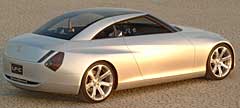Future models - Lexus - ISFirst look: Lexus previews IS futureLonger, lower and roomier: The next IS range is expected to spawn a variety of model offshoots. Lexus LF-C concept reveals a new design direction and convertible in one14 Apr 2004 TO lure more youth, Lexus is heading in a bold direction with its next generation IS200/300 range. And the BMW 3 Series-bashing baby, due here next year, should spawn a two-door four-seater coupe/convertible alongside the more traditional four-door sedan and wagon variants. These are the messages transmitted by the Lexus LF-C concept at the New York auto show. The LF-C precedes the appearance of the 2005 IS MkII range with its wedgy profile that is the work of Toyota’s CALTY styling studio in California. Central to the LF-C’s impact is a retractable hardtop first made popular in modern times by the 1996 Mercedes-Benz SLK – a model itself spawned from the IS 300-rivalling C-class sedan. The roof retracts in four positions – fully open “Speedster”, part-open “Convertible”, part-closed “Targa” and fully ensconced “Coupe”. Lexus says that the latter’s roof storage solution is possible via a relatively small boot intrusion. Mirroring the production model is the LF-C’s rear-wheel drive platform. But unlike the current IS, the LF-C’s power comes courtesy of a “high-output” front-mounted V8 engine of undisclosed specification, married to a six-speed sequential automatic gearbox. Both are sited within a wheelbase that is around 130mm longer than the current car’s 2670mm wheelbase, but the concept’s overall length of 4538mm only slightly exceeds the IS 300 thanks to short front and rear overhangs. Aiming for ample room for four adult passengers is the upshot, adds Lexus, aided by a 127mm increase in width. But the production car is unlikely to drop 50mm to the LF-C’s 1359mm stance. Suspension components are likely to continue the current car’s four-wheel independent double wishbone set-up.  To achieve stylistic strength and softness (and to avoid a slab-sided look), the LF-C combines convex and concave surfacing that, according to Lexus, “… controls the balance of light and shadow… which creates this beautiful contrast of having sharp lines within the sculpted exterior surfaces”. To achieve stylistic strength and softness (and to avoid a slab-sided look), the LF-C combines convex and concave surfacing that, according to Lexus, “… controls the balance of light and shadow… which creates this beautiful contrast of having sharp lines within the sculpted exterior surfaces”.Tapered elements exist in the turret and profile, and are repeated in the current-IS-like headlight and bold new tail-light designs. It can be also found inside, in the tapered front-to-rear console. Speaking of the interior, the LF-C’s drive-by-wire steering, steering column-mounted stacked instrumentation, Formula One-inspired gear shifter, hidden controls, transparent surfacing and lightweight bucket seats are steeped deep in motor show dreamtime. Lexus is open about its convertible’s role within its burgeoning model range, stating that the LF-C “… expands the current IS 300 sport sedan into a new category previously not addressed in the Lexus line-up”. The company’s group vice-president and general manager Denny Clements also states: "The LF-C concept is designed to target an extremely young, affluent buyer with a strong element of surprise". Now past its fifth birthday, the current IS 200/300 range represented a radical departure for the hitherto conservative premium Toyota nameplate. Carefully aping the BMW E36 3-series in size, concept and dynamic prowess, the 1999 IS opened the floodgates to worldwide praise as well as a younger demographic. Only a minor facelift has prevailed since, although Lexus has expanded the IS to include a 157kW/288Nm 3.0-litre in-line six-cylinder engine option during 2001. That same year also saw the introduction of a five-door hatchback-cum-wagon variant in some markets (but not in Australia) known as the “SportCross”. All future models Alfa Romeo Alfa Romeo Abarth Abarth Audi Audi Aston Martin Aston Martin BMW BMW Bentley Bentley Chrysler Chrysler Chevrolet Chevrolet Dodge Dodge Citroen Citroen Ferrari Ferrari DS DS Ford Ford Fiat Fiat FPV FPV Foton Foton Haval Haval Great Wall Great Wall Honda Honda Holden Holden Hyundai Hyundai HSV HSV Isuzu Isuzu Infiniti Infiniti Jeep Jeep Jaguar Jaguar Lamborghini Lamborghini Kia Kia Lexus Lexus Land Rover Land Rover Mazda Mazda Maserati Maserati Mercedes-Benz Mercedes-Benz McLaren McLaren Mini Mini Nissan Nissan Mitsubishi Mitsubishi Peugeot Peugeot Opel Opel Proton Proton Porsche Porsche Renault Renault Ram Ram Saab Saab Rolls-Royce Rolls-Royce Smart Smart Skoda Skoda Subaru Subaru SsangYong SsangYong Tesla Tesla Suzuki Suzuki Toyota Toyota Volvo VolvoIS pricing
Motor industry news |
Click to shareLexus modelsResearch Lexus All future models Alfa Romeo Alfa Romeo Abarth Abarth Audi Audi Aston Martin Aston Martin BMW BMW Bentley Bentley Chrysler Chrysler Chevrolet Chevrolet Dodge Dodge Citroen Citroen Ferrari Ferrari DS DS Ford Ford Fiat Fiat FPV FPV Foton Foton Haval Haval Great Wall Great Wall Honda Honda Holden Holden Hyundai Hyundai HSV HSV Isuzu Isuzu Infiniti Infiniti Jeep Jeep Jaguar Jaguar Lamborghini Lamborghini Kia Kia Lexus Lexus Land Rover Land Rover Mazda Mazda Maserati Maserati Mercedes-Benz Mercedes-Benz McLaren McLaren Mini Mini Nissan Nissan Mitsubishi Mitsubishi Peugeot Peugeot Opel Opel Proton Proton Porsche Porsche Renault Renault Ram Ram Saab Saab Rolls-Royce Rolls-Royce Smart Smart Skoda Skoda Subaru Subaru SsangYong SsangYong Tesla Tesla Suzuki Suzuki Toyota Toyota Volvo VolvoIS pricing
Motor industry news |














Facebook Twitter Instagram